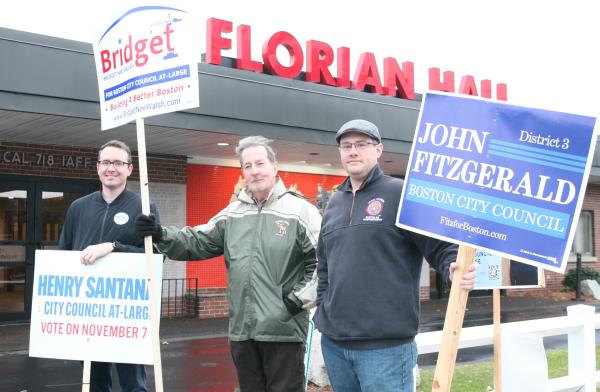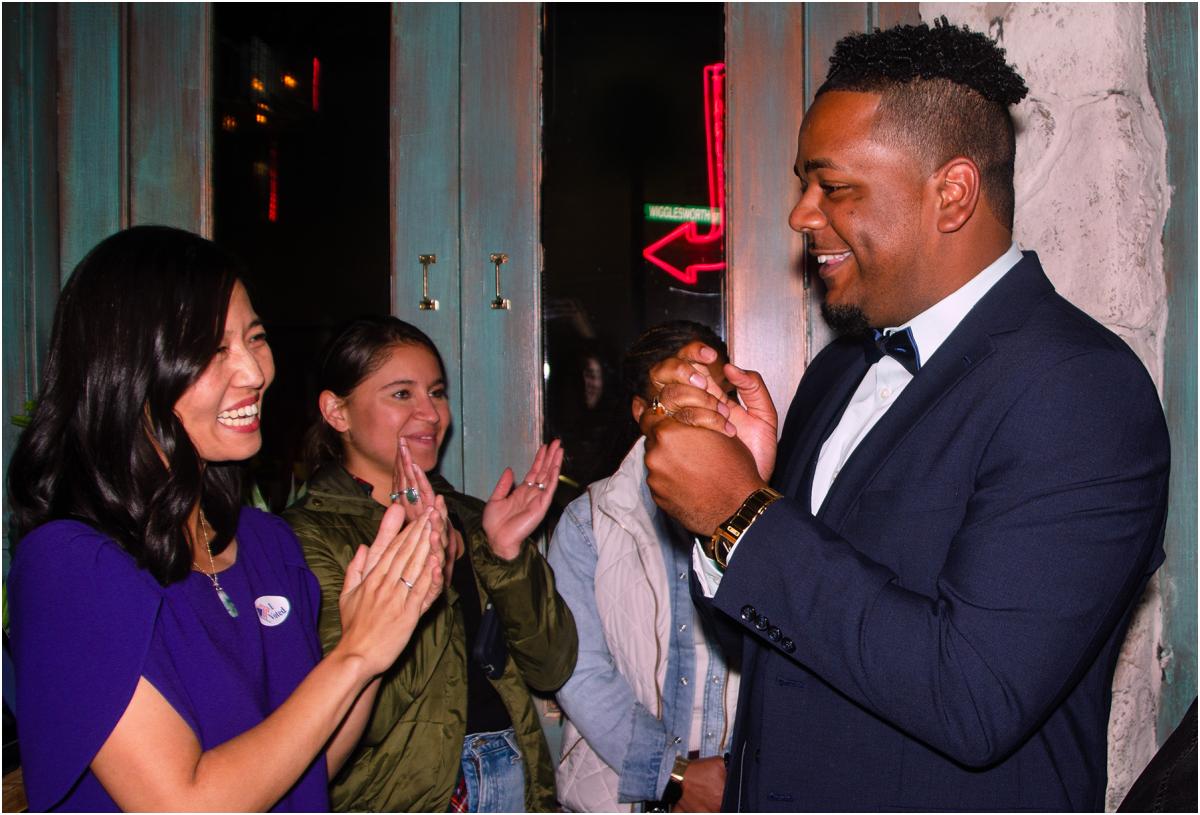November 15, 2023

Neil Doherty, James O’Neill, and Chris Sheehan campaigned for their favored candidates outside of Dorchester’s Florian Hall last Tuesday, Nov. 7. Florian’s 16-12 posted the highest single turnout for a precinct in the city by percentage — 52.62 percent. Seth Daniel photo
In some ways, this year’s election for Boston City Council was like its predecessor in 2007. There was no race for mayor, no preliminary round for candidates at-large, and a citywide incumbent named Murphy finished second, with a strong showing in Dorchester, South Boston and West Roxbury.
But in 2023, the top vote-getter running at-large in 2007—and even in 2021, Michael Flaherty, was no longer on the ballot. The new top vote-getter was a first-term incumbent from Hyde Park, and the first Haitian American to serve on the council, Ruthzee Louijeune. Instead of an open seat being filled by another candidate from South Boston, the new at-large member is Henry Santana, a 27-year-old Dorchester resident, native of the Dominican Republic, and previously an aide to Mayor Wu and former City Councillor Kenzie Bok. But, of the four newly elected councilors, three have worked in City Hall.
Though the election results have been interpreted as a gain or loss for the candidates and their supporters, the numbers also show a changed political landscape, with a shift in electoral clout from some parts of Boston to others, and between generations. Ward 20 (West Roxbury and part of Roslindale) remains an electoral powerhouse, with voter turnout this year at 33.7 percent, the highest among Boston’s 22 wards and well above the citywide average of slightly less than 19 percent.
But growth in the number of voters registered and votes cast in Ward 20 were no match for the steeper climbs in Ward 19 (most of Jamaica Plain and part of Roslindale) and Ward 3, which goes from the SoWa/Ink Block section to the South End to Chinatown, the Leather District, the Financial District, and the North and West Ends. Since 2007, the ward has been transformed by new housing development, with enrollment up by 31.9 percent and votes cast by 148.5 percent. If the trend in these wards was like a hill, Ward 20 was more like a speed hump.
Ward 19 had the second highest ward turnout figure, at 31.5 percent. Since 2007, its total of registered voters has increased by more than 14 percent and the number of votes cast by 125 percent. In six adjacent precincts of Ward 11, between Forest Hills Station and Egleston Square, an area with recent development of high-density, transit-oriented housing, the number of registered voters has increased by 48.8 percent. The number of votes cast was up over the 2007 total by 151.2 percent.
In this year’s election, Louijeune repeated her first-place finish in Ward 18, which includes her own neighborhood in Hyde Park, along with parts of Mattapan and Roslindale. But she also ran first in some of the city’s hotbeds for growth in voters, such as Ward 3, Ward 19, and the six adjacent precincts in Ward 11—including the former location of the bar and repository for Boston political memorabilia, Doyle’s Café. The second-place finisher in Ward 19 was Santana.
Among the other places where Louijeune came in first were Ward 22 (Brighton/North Allston) and Ward 5, which includes the Back Bay, along with parts of Beacon Hill and the South End. Ward 5 was unusual for having fewer registered voters than in 2007, but its turnout was above the citywide average and the number of votes cast was up by 140.5 percent.
A Dorchester resident also in her first term on the council, Erin Murphy captured first place in Wards 13 (Uphams Corner/Columbia-Savin Hill) and 16 (Neponset). Her strongest support in Dorchester was from two areas with perennially high turnouts: Ward 13, Precinct 10 (Savin Hill) and Ward 16, Precinct 12, which includes the Keystone Apartments and posted the highest turnout figure for all Boston precincts, at 52.6 percent.
Murphy also ran first in Ward 20, Ward 2 (Charlestown) and Ward 1 (East Boston). She also prevailed in Ward 1 precincts around Orient Heights, while Louijeune, with the second highest total, carried areas that included recently developed housing on the waterfront.
Murphy was also the top vote-getter at-large in South Boston. Despite running below the citywide average for voter turnout this year, South Boston has seen—along with new transit-oriented housing and development of the Seaport District, an increase of registered voters since 2007 by 58.1 percent, but the number of votes cast was up by 27.3 percent. In Ward 16, the number of registered voters increased less dramatically over the 2007 figure, but votes cast were up by 44.9 percent, thanks to above-average turnout at 26 percent.
Elsewhere in Dorchester, second-term councilor at-large Julia Mejia finished first in Wards 14 (Grove Hall-Franklin Field and part of Mattapan) and 15 (Bowdoin-Geneva, Meeting House Hill). Louijeune came in second in those areas, and in Ward 20. But Mejia was a front-runner in Roxbury’s Wards 8, 9 and 12, and in the precincts north of Egleston Square in Ward 11.
Another factor in turnout was the competition for district seats on the council, especially in Districts 3, 5, and 6, where no incumbents were on the final ballot.
In District 3, which includes more eastern precincts of Dorchester, from South Bay and the Polish Triangle to Cedar Grove, two finalists were competing to succeed Frank Baker, who decided earlier this year not to seek re-election. The winner was John FitzGerald, with 58.2 percent of the vote.
The other District 3 finalist, Joel Richards, carried 17 precincts, but most of the precincts won by FitzGerald were in areas with higher turnouts, including Ward 13, Precinct 10 (Savin Hill) and Ward 16, Precinct 12 (Keystone Apartments). The son of Kevin Fitzgerald, a former state representative from Mission Hill, District 3’s winner has worked in City Hall for 17 years. His campaign had a sizeable advantage in fundraising and a cross-section of support, from labor unions to elected officials, including former Boston mayor Marty Walsh.
Walsh also backed Murphy, but he was less successful in his backing of José Ruiz, the losing finalist for City Council in District 5 (Hyde Park, Roslindale and part of Mattapan). Ruiz had endorsements from police and firefighters, along with independent support from the Forward Boston political action committee—grouped in a slate with Murphy, Fitzgerald, District 6 runner-up William King, and the fifth place at-large candidate Bridget Nee-Walsh. Funded mainly by the chair of New Balance, Jim Davis, the PAC raised $320,000 and spent more than one-third of that amount on behalf of Ruiz.
The winner in District 5, supported by Wu, was Enrique Pepén. A former aide to the mayor and other elected officials, along with being the son of Nilson Pepén, the Spanish-language play-by-play announcer for the Boston Red Sox, he captured 52.75 percent of the vote. The Bold Bost PAC—funded by four labor unions—spent on behalf of Pepén, but its largest amount was devoted to Santana.
Ruiz, a retired police officer who lives in Readville, won a single precinct in Mattapan and was a clear winner in Hyde Park. Pepén won most of the precincts in Mattapan and Roslindale. The District 5 incumbent, Ricardo N. Arroyo, was eliminated in the preliminary election. He won his first term in 2019, as a progressive and political ally of Wu. Four years later with Pepén, Wu was backing a fellow resident of Roslindale who had been the director of her Office of Neighborhood Services.
Wu also backed winners in District 8 (Back Bay, Fenway, Mission Hill), Councilor Sharon Durkan, and West Roxbury and Jamaica Plain’s District 6 (Ben Weber), along with at-large candidate Santana, who finished in fourth place.
Sixteen years ago, officials and community leaders were quick to acknowledge the 2007 “off-year” election as an embarrassment, with its voter turnout a mere 13.6 percent—worse than the figure of almost 19 percent last Tuesday.
One factor in the turnout difference is the increase in Boston’s population. Between 2000 and 2020, the count increased by 14.2 percent, an amount likely somewhat diminished since the onset of Covid. Though the comparison is not exact, between 2007 and this year, the number of registered voters increased by 21.7 percent, while the number of votes cast was 69 percent higher than 16 years ago—not exactly a slump in political engagement.
By 2020, 56.7 percent of Boston’s voting-age population was under forty years of age – people who had never voted before 1999. If candidates endorsed by Walsh had mixed results in this year’s election, he could still claim the surge in housing production under his administration helped generate electoral dividends for other candidates, especially Louijeune.

Mayor Michelle Wu and Councillor-elect Henry Santana greeted each other at Santana’s victory celebration at Yellow Door Taqueria in Mission Hill on Nov. 7. Chris Lovett photo
The youngest at-large candidate, Henry Santana, held his victory celebration in his old neighborhood, a few blocks from the Mission Hill Main housing development that used to be home for him and—in its earlier form—of former state representative Jeffrey Sánchez, and a few more blocks from the childhood home of Kevin Fitzgerald. The event was at the Yellow Door Taqueria, previously the site of a pub named for an Irish writer of quirky genius, Flann O’Brien.
When the pub was still in business, a larger-than-life semblance of O’Brien, hoisting his “pint of plain,” towered above the entrance with its red door. On election night, the door had a different color, and pints were outnumbered by baskets of house-made tortilla chips with salsa. When Santana made his entrance, he was hailed by a packed, jubilant crowd, with many—including Wu—who had never cast a vote in the 20th century.
That did not prevent a longtime neighborhood resident in the crowd from remembering Santana as a local teen volunteer who would later head Wu’s Office of Civic Organizing. When Santana addressed the crowd, standing on a bench next to the mayor and wearing a black jacket and bow tie, his words might have been spoken by another candidate from another time.
“I’m a city kid,” he declared. “I grew up in public housing. I am a product of the Boston Public Schools, I’m a product of after-school programs and summer programs here in this city, and I’m proud to be your next Boston city councillor.”


